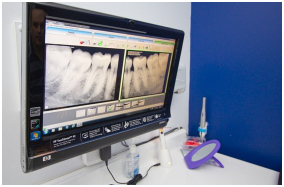A dental Cone Beam CT scanner a specific type of x-ray machine producing detailed 3-D images of your teeth, jaws, nerve pathways and soft tissues in just a single scan. We may suggest you have a cone beam CT scan in Ajax when regular 2-D dental x-rays don’t provide enough information. With this scan, a cone-shaped x-ray beam moves around your head, producing many images to create a 3-D scan.
Why Would I Need a Cone Beam CT Scan?
A cone beam CT scan can be used in many situations, and it’s especially useful for more complex dental treatments such as surgically planning the removal of impacted teeth, or for diagnosing jaw joint problems. It provides accurate images allowing us to evaluate your jaw, nerve canals, sinuses and nasal cavity and is especially useful when we plan dental implant treatment in Whitby. Cone beam CT scans are also used for reconstructive surgery.
What Is the Procedure for a Cone Beam CT Scan?
You don’t need to do any special preparation, and the scan is quite quick to complete. Before your scan, you will need to remove anything that could interfere with the images such as glasses, hearing aids, jewellery or hairpins, or other metal objects. If you have any removable dental work, you might need to take it out, but it’s best to bring it with you to the examination as we may need to examine it as well.
The cone beam CT scanner is a square-shaped machine that has a special, comfortable device to ensure your head is held gently in place. We will make sure you are correctly and comfortably positioned before we begin the scan. The CT scanner has a rotating arm that will go all the way around your head while it captures multiple images from different angles. These images are put together to create a single 3-D CT scan in Pickering. All you need do is remain very still while the arm revolves around you, a process that typically takes between 20 and 40 seconds. The entire procedure is painless and non-invasive but provides us with a wealth of information.
What Happens Afterwards?
After your cone beam CT scan in Oshawa, you can return to everyday activities, and our dentist will analyze the image to diagnose or plan treatment. If you intend having dental implants or need bone grafting, this scan is invaluable for ensuring your treatment is as successful as possible.
How a Cone Beam CT Scan Helps Plan Implant Treatment
Although we can examine your teeth and jaws visually, we can’t see what’s hidden below and to the x-rays don’t provide enough information for dental implant placement in Courtice. With your CT scan, we can determine if you have enough bone for implants, which is extremely important. The problem is that soon after tooth loss, the bone that used to surround your teeth immediately begins to resorb, and if you lost teeth quite some time ago, your bone could be slightly too thin for implant placement. It’s an issue that is often easily overcome with bone augmentation, where additional bone is grafted onto areas where it is deficient.
The scan also tells us exactly where important structures like nerves and sinus cavities are located, as these must be avoided when we place your Newcastle dental implants. We can digitally manipulate the 3-D images when deciding where to best place your dental implants, which is critical for ensuring that once restored, your dental implants look, feel and function correctly. Meticulous planning is one of the secrets of successful implant treatment, and the plan created using your scan is used during your computer guided surgery at Durham Dental Solutions.


